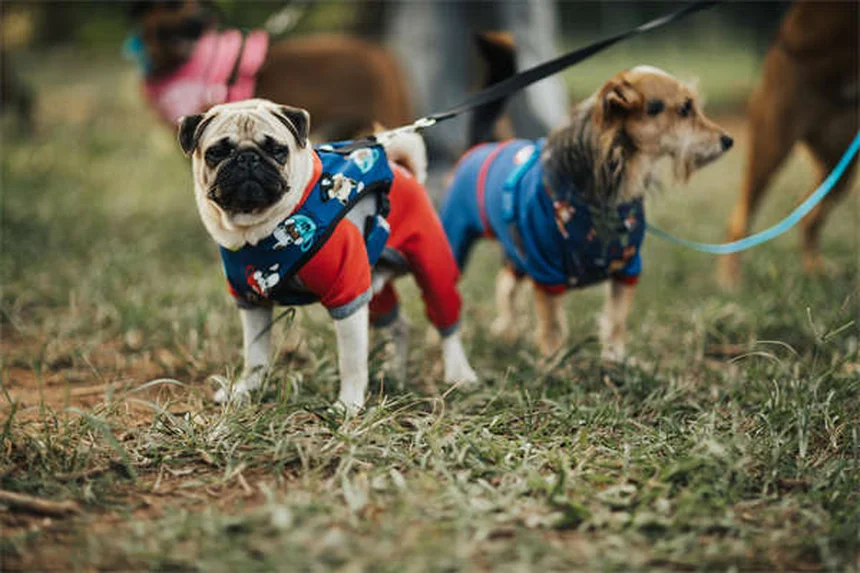Advertisement
Why do snakes bite dogs? The simple answer is: snakes bite dogs when they feel threatened. As a dog owner myself, I've learned that our curious pups often don't realize they're scaring snakes when they get too close. The truth is, snakes aren't out to attack dogs - they're just defending themselves when they feel cornered. In this article, I'll walk you through exactly why these encounters happen, how to spot the signs of a snake bite, and what to do in those critical first minutes that could save your dog's life. Whether you live in snake country or just take occasional hikes, this information could make all the difference for your furry friend.
E.g. :Top 10 Most Popular Dog Breeds in America (2025 AKC Rankings)
- 1、Why Do Snakes Bite Dogs? Let's Get to the Bottom of This
- 2、Spotting Trouble: Signs Your Dog Got Snake-bit
- 3、Emergency Response: What To Do RIGHT NOW
- 4、Vet Care: What Happens Behind Those Clinic Doors
- 5、Prevention: Keeping Your Pup Safe
- 6、Understanding Snake Behavior Beyond the Bite
- 7、Dog Psychology: Why They Can't Resist Snakes
- 8、Snake Avoidance Training That Actually Works
- 9、When Prevention Fails: Advanced First Aid
- 10、Long-Term Effects You Might Not Expect
- 11、FAQs
Why Do Snakes Bite Dogs? Let's Get to the Bottom of This
It's Not Personal - Snakes Just Get Scared
Picture this: your curious pup spots something slithery in the grass. Before you can say "no!", they've got their nose right up in that snake's business. Here's the thing - snakes don't wake up thinking "I'm gonna bite a dog today." They strike when they feel threatened, and let's be honest, our dogs can be pretty threatening when they're being their curious selves.
I've seen it happen - a dog friend of mine, let's call him Max, got too close to a garter snake last summer. That poor snake probably thought Max was a giant predator! The snake reacted instinctively, and bam - Max got a painful lesson about respecting personal space. The good news? Most North American snakes are nonvenomous, so while the bite hurts, it's rarely life-threatening.
When and Where These Bites Happen
You might wonder - how common are snake bites really? Let me break it down for you:
| Activity | Risk Level | Common Snake Types |
|---|---|---|
| City walks | Low | Garter snakes |
| Hiking in rocky areas | Medium | Rat snakes, bullsnakes |
| Exploring desert regions | High | Rattlesnakes, coral snakes |
See that? Your urban pup is pretty safe, but if you're like me and love taking your dog on wilderness adventures, we need to be extra careful. Rocky areas and tall grass are snake hotspots, especially during warmer months when snakes are most active.
Spotting Trouble: Signs Your Dog Got Snake-bit
 Photos provided by pixabay
Photos provided by pixabay
The Obvious Signs You Can't Miss
So how do you know if your dog's been bitten? Let me tell you about Bella, a golden retriever I know who had a run-in with a snake. Her owner noticed immediate swelling on her paw, along with two small puncture wounds. The area turned red and painful to touch - classic signs of a snake bite.
But here's something important: not all bites leave obvious marks. Small snakes might not leave visible wounds, and venomous bites can sometimes look deceptively minor at first. That's why we need to look for other clues like sudden limping, excessive licking at one spot, or unusual behavior. When in doubt, check it out! Better safe than sorry when it comes to our furry friends.
The Scary Stuff: Signs of Venom
Now let's talk about the more serious symptoms that mean you need to move fast. Venomous bites can cause:
- Pale gums (check by lifting your dog's lip)- Heavy drooling or foaming at the mouth- Weakness or collapse- Trouble breathing- Tremors or shaking
Did you know dogs show symptoms faster than humans? That's because their smaller bodies react more strongly to venom. A dose that might make you sick could be deadly for your pup. That's why we can't waste time if we suspect a venomous bite.
Emergency Response: What To Do RIGHT NOW
First Steps When Bite Happens
Okay, let's say the worst happens - you see a snake bite your dog. Here's exactly what to do:
1. Grab your phone and snap a picture of the snake (from a safe distance!)2. Lift your dog and carry them to your car - no walking allowed!3. Call your vet or emergency clinic while driving4. Keep the bitten area below heart level
Wait - why shouldn't you let your dog walk? Because movement spreads venom faster through their system. And that photo? It could save precious minutes in identifying the snake and getting the right treatment.
 Photos provided by pixabay
Photos provided by pixabay
The Obvious Signs You Can't Miss
You might have heard old-school advice about snake bites. Let me tell you why most of it is bad news:
- No ice - it can make tissue damage worse- No tourniquets - you'll do more harm than good- No sucking out venom - that's just Hollywood nonsense
Here's a question I get a lot: "Should I try to kill the snake for identification?" Absolutely not! You might get bitten yourself, and a dead snake is harder to identify than a live one. Just get that photo if you can do it safely.
Vet Care: What Happens Behind Those Clinic Doors
The Treatment Process Explained
When you arrive at the vet, here's what you can expect. First, they'll assess your dog's condition. For nonvenomous bites, treatment might be as simple as cleaning the wound and prescribing antibiotics. But venomous bites? That's when things get serious.
The vet might give antivenom - the superhero of snake bite treatments. They'll also likely start IV fluids to combat shock, pain meds to keep your pup comfortable, and possibly antihistamines. Severe cases might need oxygen therapy or even a ventilator. It's intense, but modern vet medicine works wonders!
Recovery and What Comes Next
After the emergency treatment, your dog might need to stay hospitalized for observation. Recovery times vary:
- Mild cases: 24-48 hours- Moderate bites: 3-5 days- Severe envenomation: 1-2 weeks
You'll need to watch for complications like infection or tissue damage. And here's a pro tip: ask your vet about follow-up blood tests to check organ function. Some venom effects show up days later.
Prevention: Keeping Your Pup Safe
 Photos provided by pixabay
Photos provided by pixabay
The Obvious Signs You Can't Miss
Living in snake territory? Here are my top tips:
- Keep your dog on leash in high-risk areas- Stick to clear trails and avoid tall grass- Consider snake avoidance training (yes, it's a thing!)- Make noise while hiking - snakes will usually move away
Another question I hear: "Are some dogs more at risk than others?" Absolutely! Young, curious dogs and hunting breeds are most likely to investigate snakes. Small dogs are at greater risk from venom due to their size. But any dog can get bitten if they surprise a snake.
Know Your Local Snakes
Take some time to learn about snakes in your area. Your local wildlife agency probably has great resources. Here's why this matters:
- You'll know which ones are venomous- You'll understand their habitats and habits- You'll be better prepared in an emergency
Remember, most snakes just want to be left alone. If we respect their space and keep our dogs under control, we can all coexist safely. Now go give your pup some extra love - and maybe work on that "leave it" command!
Understanding Snake Behavior Beyond the Bite
Why Snakes Choose Certain Areas
Ever notice how you always seem to find snakes in the same spots? There's actually a fascinating reason behind this. Snakes are cold-blooded creatures, which means they rely on their environment to regulate body temperature. That sunny rock your dog loves to sniff around? That's prime real estate for a snake looking to warm up.
I remember hiking with my neighbor's dog last spring - we kept seeing garter snakes near a small creek. Turns out, snakes love areas with both sun and shade options, plus access to water and food sources. Here's a fun fact: snakes can go weeks without eating after a big meal, but they'll stick close to reliable water sources. That's why we often find them near ponds, streams, or even backyard water features.
The Surprising Benefits of Having Snakes Around
Now, I know what you're thinking - "Beneficial? Those bitey creatures?" Hear me out! Snakes play a crucial role in controlling rodent populations. A single rat snake can eat dozens of mice and rats each year. That means fewer rodents getting into your trash, spreading diseases, or chewing through your garden hoses.
In my own backyard, I've noticed fewer mice since a garter snake family moved in under my shed. Sure, I keep my dog on a leash when we're near their hangout spot, but I've come to appreciate these slithery pest controllers. Nature's balance is pretty amazing when you think about it - snakes help keep other potentially more troublesome animals in check.
Dog Psychology: Why They Can't Resist Snakes
The Nose Knows: Canine Curiosity Explained
You've seen it - that intense focus when your dog catches an interesting scent. A dog's sense of smell is anywhere from 10,000 to 100,000 times more acute than ours. When they detect snake scent, it's like someone waving a giant "CHECK THIS OUT" sign in their face.
My friend's beagle, Daisy, once dug up an entire snake den because she couldn't resist the smell. The movement, the unique scent profile - it's sensory overload for our canine companions. Younger dogs are especially prone to investigating snakes because their curiosity often overrides caution. It's not that they're being disobedient - their instincts are just incredibly strong.
Breed Differences in Snake Encounters
Not all dogs react the same way to snakes. Here's a quick comparison of common breed reactions:
| Breed Type | Typical Reaction | Risk Level |
|---|---|---|
| Terriers | High prey drive, may attack | Very High |
| Herding Dogs | May circle and bark | Medium |
| Scent Hounds | Intense tracking | High |
| Companion Breeds | Often avoid | Low |
See how different breeds approach snakes? That's why training needs to be tailored to your dog's natural tendencies. My neighbor's Jack Russell needs constant "leave it" reinforcement, while my lazy bulldog mostly just snorts at snakes and walks away.
Snake Avoidance Training That Actually Works
Modern Methods Beyond Shock Collars
Remember when snake avoidance training meant painful shocks? Thankfully, we've come a long way! Positive reinforcement techniques using scent association can be incredibly effective. I've worked with trainers who use snake-scented towels to teach dogs that snakes equal "walk away."
The key is starting young and being consistent. We pair the snake scent with a strong "leave it" command and high-value treats when the dog complies. Over time, they learn that ignoring snakes leads to chicken bits - much better than a face full of venom! Pro tip: refresh this training seasonally, especially before peak snake activity periods.
Creating Snake-Smart Habits at Home
You can set up your yard to naturally discourage snake visits. Try these simple tricks:
- Keep grass trimmed short (snakes hate feeling exposed)- Remove wood piles and debris near the house- Use gravel or mulch instead of dense ground cover- Install snake-proof fencing if you're in high-risk areas
I recently redid my backyard with these principles in mind, and the difference has been remarkable. Fewer snake sightings means less stress when I let my dogs out to play. Plus, it looks nicer too - bonus!
When Prevention Fails: Advanced First Aid
Building a Dog First Aid Kit for Snake Country
If you live where venomous snakes roam, your regular first aid kit needs upgrades. Here's what I always pack:
- Vet wrap (for light bandaging without cutting circulation)- Children's Benadryl (check dosage with your vet first)- Saline flush (for cleaning wounds)- Emergency vet contacts (programmed in your phone and printed)
Throw in a spare leash too - you might need to quickly restrain your dog after a bite. I keep mine in a bright orange bag so it's easy to find in a panic. Trust me, when your dog's been bitten, you don't want to waste time searching for supplies.
The Critical First 30 Minutes
Time is tissue when dealing with venomous bites. Here's a timeline of what happens:
0-5 minutes: Venom begins spreading locally5-15 minutes: Systemic symptoms may appear15-30 minutes: Significant tissue damage begins
This is why having a plan matters so much. Know your nearest emergency vet's location and the fastest route there. Practice loading your dog quickly into the car. These small preparations could save your dog's life when seconds count.
Long-Term Effects You Might Not Expect
Physical Recovery Isn't Always Straightforward
Even after the immediate danger passes, some dogs experience lingering effects. Tissue necrosis can continue developing days after the bite, requiring wound care or even surgery. I've seen dogs need skin grafts for severe rattlesnake bites.
Joint stiffness near the bite site is another common issue. My cousin's border collie needed months of physical therapy after a copperhead bite to her front leg. The vet explained that venom can damage small blood vessels feeding muscles and joints. Patience and follow-up care make all the difference in full recovery.
The Emotional Impact on Dogs
We often forget that traumatic experiences affect dogs psychologically too. Some dogs develop lasting fear of areas where they were bitten, while others become hyper-vigilant about scents. I've worked with several dogs who needed behavioral therapy after snake encounters.
The good news? Most dogs bounce back with time and positive reinforcement. Gentle reintroduction to outdoor spaces, paired with lots of treats and praise, helps rebuild confidence. Just like us, they benefit from emotional support after scary experiences.
E.g. :Snakebites in Animals - Toxicology - Merck Veterinary Manual
FAQs
Q: How can I tell if my dog was bitten by a snake?
A: Look for these telltale signs: swelling at the bite site (often the face or legs), sudden pain or limping, and sometimes two small puncture wounds. But here's what many dog owners don't realize - not all snake bites leave visible marks. That's why we need to watch for other symptoms like excessive drooling, pale gums, or unusual lethargy. If your normally energetic pup suddenly seems "off" after being outdoors, don't wait - get to the vet. Remember, dogs show symptoms faster than humans because of their smaller size, so time is critical.
Q: What should I do immediately after a snake bites my dog?
A: First, stay calm (I know it's hard!). Here's exactly what we recommend: 1) Safely move your dog away from the snake, 2) Carry your dog to your car - no walking allowed as it spreads venom faster, 3) Try to snap a photo of the snake from a safe distance, and 4) Call your vet while en route. The most important thing? Don't waste time on home remedies - getting professional help quickly gives your dog the best chance of recovery.
Q: Are all snake bites dangerous to dogs?
A: Not all snake bites are created equal. Here's the breakdown: nonvenomous snake bites (like from garter snakes) typically cause localized pain and swelling but aren't life-threatening. However, venomous bites from rattlesnakes, copperheads, or coral snakes can be extremely dangerous. The scary part? You might not know which type bit your dog. That's why we treat every snake bite as potentially serious until proven otherwise. Better safe than sorry when it comes to our furry family members!
Q: How can I prevent snake bites when hiking with my dog?
A: As someone who hikes with dogs regularly, I swear by these prevention tips: 1) Keep your dog on leash in snake territory, 2) Stick to clear trails and avoid tall grass where snakes hide, 3) Consider snake avoidance training (it works!), and 4) Make noise while hiking - snakes usually retreat from vibration. Pro tip: Early morning and evening are peak snake activity times, so plan your hikes accordingly. A little prevention goes a long way in keeping your pup safe.
Q: What's the survival rate for dogs bitten by venomous snakes?
A: Here's some good news - with prompt veterinary treatment, most dogs survive even venomous snake bites. Studies show survival rates over 90% when treated quickly with antivenom. But timing is everything - the sooner you get help, the better the outcome. That's why we can't stress enough how important it is to head straight to the vet at the first sign of trouble. Remember, your quick action could make all the difference for your beloved pet.


















